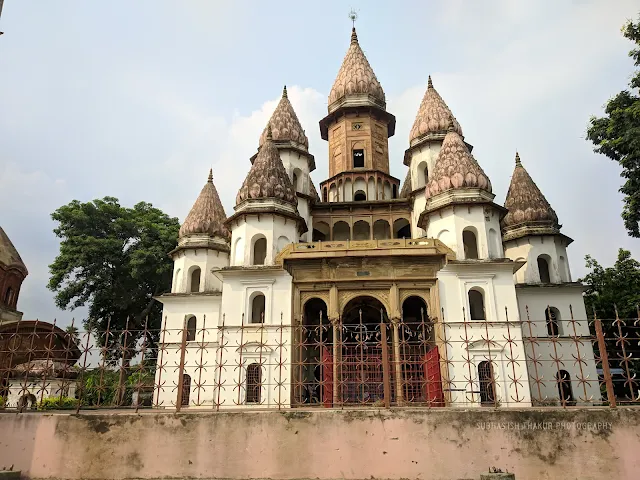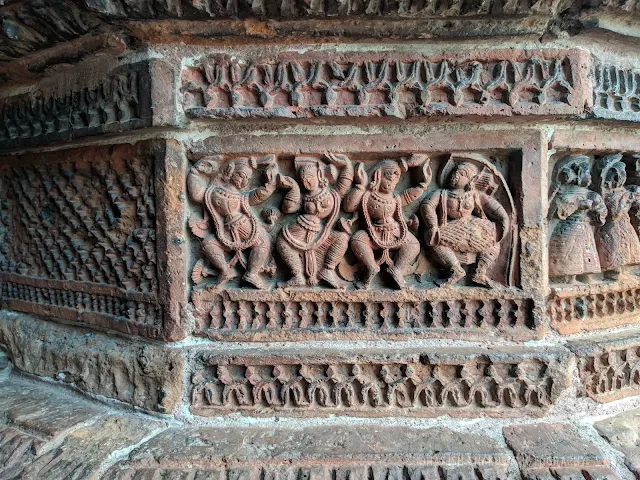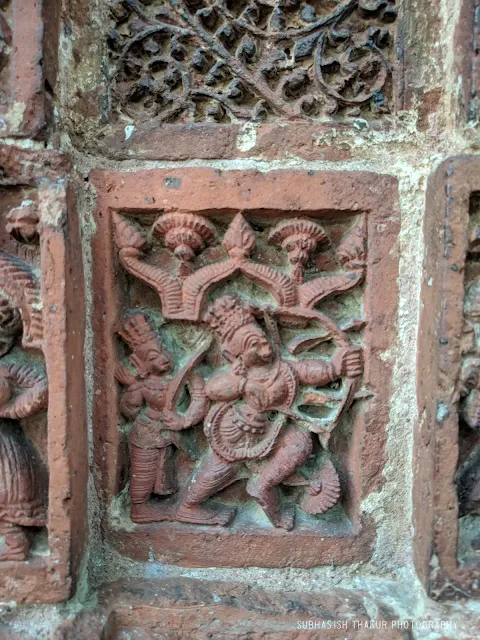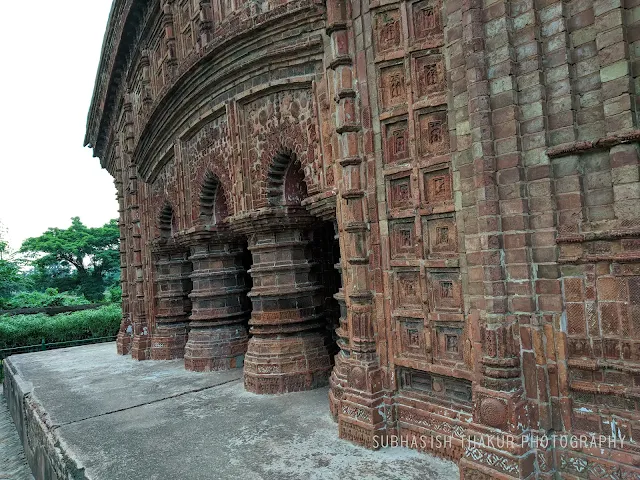I had a distinct fascination with temples and I love to learn about old architecture and feel the history. I want to visit temples and feel the history by touching the walls of temples. And from this affection, I went to Hanseswari Temple on a winter afternoon.
Hanseswari Temple

Located in a beautiful quiet place and the Ganga floes by the side. There are many stories of destruction in the flow of water. In 1799, Banshambati Raja-Nrsimhadeva Roy started the construction of the Hanseswari temple. But he died while building this temple. The work was completed in 1814 with the strong intervention of Rani Shankari Devi. Decorated with thirteen pinnacles shaped like lotus buds, the unique temple and its style of architecture still fascinate art lovers.
Built on the foundation of Shatchakraved Yoga. Built-in the six chakra system, this temple with its thirteenth padmakaraka decorated pinnacle houses Kulkundalini Shaktirupi Mahamaya, Adyaswarupini Hanseswari. The term Hanseswari also has multiple spiritual meanings. As the soul is like a goose. Just as the goose is able to separate the milk from the milk and take the milk, so also the soul can leave the vain things of the world and rush towards the Supreme Soul.
There is a moat around this temple. Which is called average in current parlance. At the entrance, there is a huge nahwatkhana. The impression of dilapidation in Nahavatkhana is due to renovation and age. Plasters are falling from the walls. Hanseshwari Maa Temple is a few steps away from Nahavatkhana. Inside is the seat of Panchamundi of Hanseswari. Three-cornered altar on a thousand lotuses. Mother sitting on the twelfth lotus from Mahadeva's heart. The mother's complexion is blue, with a veil on her head. Mother has a calm form throughout the year. But in the Kali Puja of the month of Kartik, the mother takes the form of Elokeshi for one night.
 |
| Hanseswari Temple |
- History of Temple :
The original residence of the Dattarays of Banshberia royal family was in Patuli of Burdwan. The family has always served as trusted servants of the Mughal emperors and as a result, received the title of "Rai" from the Mughal emperor Akbar and the title of "Majumdar" from his son Jahangir. There were only four Majumdar families in Bengal at that time, among which Bhavananda, the ancestor of the Krishnanagar royal family of Nadia, is notable, apart from the Dattarai of Patuli.
Raghav Dattaray, the progenitor of the Dattaray family of Patuli, received the zamindari of 21 Parganas of the then Satgaon (now Saptagram) from the Mughal Emperor Shah Jahan in 1656 AD. After some time, his son Rameshwar Roy left Patuli's paternal house and moved to the family home. He brought around 360 families of Brahmins, Kshatriyas, Kayasthas, Vaidyas, and others from different parts of Bengal and settled in Vangsbati. He also brought several Pathan warriors who were entrusted with the defense. At that time there were various disturbances in the governance system of Bengal. Many zamindars were negligent in paying the correct revenue in Delhi.
Rameshwar brought this matter to the attention of Delhi Emperor Aurangzeb and played a significant role in formulating a proper revenue system. As a result, Emperor Aurangzeb was pleased to grant Rameshwar's family the Panja-Percha Khelat and the hereditary title of "King-Mahasoy".
 |
| Hanseswari Temple Terracotta Ideograph |
The construction of the Hanseswari temple was started by Nrisimhadeva Ray, the great-grandson of King Rameshwar Ray. In between, many storms have swept over the Bhanshberia Rajbari. On the untimely death of Govindeva, the grandson of Rameshwar Ray and the father of Nrsimhadeva, several parts of the zamindari were lost. Later, with the help of Warren Hastings and Lord Cornwallis, some of the stolen lands were recovered, but to recover the whole, an application had to be made to the Court of Directors in London.
The matter was costly in time and money. But at this time the then king Nrsimhadeva left Kashi and from 1792 to 1799 he practiced tantra from Kashi and wrote a book called 'Uddishtantra'. In 1799 AD he returned from Kashi and instead of retrieving the ownership of the zamindari, he thought of building a temple in Tantra with the money he had saved for his trip to London. Seeing the dilapidated state of the Ananta Vasudeva temple built by his great-grandfather, he decided to build a stone temple instead of a terracotta temple will make
.webp) |
| Excellent architectural Ideograph in Hanseswari Temple Banshberia |
The foundation stone of the temple was laid in 1799 AD. But unfortunately in 1802 AD Nrisimhadeva passed away while the work of the temple was unfinished. Nrisimhadeva's first wife passed away. Nrisimhadeva's second wife, Rani Sankari, completed the unfinished temple of her husband in 1814 AD. It is said that the stone for the construction of the temple was brought from Chanar in Uttar Pradesh and the craftsmen of the temple were brought from Jaipur in Rajasthan. The architectural style of the temple is reminiscent of the Shekhawati Haveli construction style of northern Rajasthan. A total of Rs 5 lakh was spent to build the temple.
.webp) |
| Pleasant scenery of the temple premises |
- Architecture :
Shatchakraved and temple architecture The Hanseswari temple is built following the Shatchakraved theory of Tantric Sadhana. According to Tantric Yoga, there are pulses, centered on the spinal cord of the human body including Ira, Pingala, Vajraksha, Sushumna, and Chiarini, centered on the Sushumnakanda. There are 6 Chakras at different places along this Sushumnakanda. The lowest chakra of these chakras is called Muladhara Chakra which houses the serpent form 'Kulkundalini'. At the very top of this Kulkundalini is Shiva i.e. God. Awakening this Kulkundalini through Yoga-Sadhana on the path shown by the Guru is considered to be the ultimate goal of a Tantra Sadhaka to reach Sahasrara from Muladhara. Tantric Nrisimhadeva wanted to portray this Kulkundalini theory of the human body through the architecture of the temple.
In the sanctum sanctorum of the temple, Goddess Hanseswari, the Kundalini Shakti, is present on top of a thousand lotuses. Five steps rise up through different places in the temple as a metaphor for the five main pulses. Ascending this staircase there is a strange labyrinth that, once entered, is difficult to escape without the aid of a guide. In one place of this labyrinth, a white stone Sadasiva is present in a hidden chamber. This means that it is possible to connect the power of Muladhara through Nadi with Shiva located in Hridipad only by following the path shown by the true Guru. The Tantric term for this is 'Shatchakrabhed'. Folk-culture researcher and sociologist Vinay Ghosh has rightly said about this temple, "Hanseswari temple is the direct form of Tantric yoga practice."
 |
| The architectural beauty of the Temple (Pic: 1) |
 |
| The architectural beauty of the Temple (Pic: 2) |
 |
| The architectural beauty of the Temple (Pic: 3) |
 |
| The architectural beauty of the Temple (Pic: 4) |
- Hansha Meaning :
What is 'goose'? According to Tantra, the human body is constantly chanting the sound 'Hong' with inhalation and the sound 'Sah' during exhalation. This is called Hansa Mantra or Ajpa Mantra. Even if this mantra is not chanted, it is constantly being chanted by itself with the coming and going of the breath. According to the tantra, the 'goose' is Bhagavati herself, the great power Kulkundalini. Shiva and Shakti are identical. This undifferentiated relationship is revealed in Hansa Mantra. So Shabdarupini Devi is always established in the hearts of people. According to Hansopanishad, “Ahmiti Bijam. Sa eti Shakti: Sohhmiti Keelkam”. That is, 'Hong' is the seed, 'Sah' is the energy, and 'Sohang' is the wedge or means. It is with the help of this mantra that the Hansatma mediated by the eight lotuses of the heart is seen. A direct form of this idea can be seen in the Hanseswari statue of Banshberia.
 |
| Devi Hanseswari |
- How to go Hanseswari Temple:
From Howrah take Katowa local and alight at Banshberia station, take auto/tuk-tuk from the station to reach Hanseswari temple.
From Bandel station also get an auto or mini-bus (Bandel – Kuntighat / Triveni) to Hanseswari temple. So if you don't get Katwa local, you can reach Bandel by taking any train on the Howrah main line.
And if you think of going by road, then you can conveniently choose any of the following three roads –
1. From Nimta reach Kalyani via Kalyani Expressway. There, after crossing the Ganges through the Ishwar Gupta Bridge, you will find a short road to Hanseshwari Temple on the left-hand side.
2. From Bali take State Highway 13 (currently Delhi Road) to Magra. From there take State Highway 6 to Kalyani Expressway from Jhulania Mor in Banshberia. Just before climbing the Ishwar Gupta Setu, you will find a small road leading to Hanseshwari Temple on the right.
 |
| Hanseswari Temple |
You may want to read this post :
- Shibnibas- The Story of Lord Shiva
- Ranaghat Siddheswari Kali Mandir
- DakatGari Math and its common folk story











0 Comments